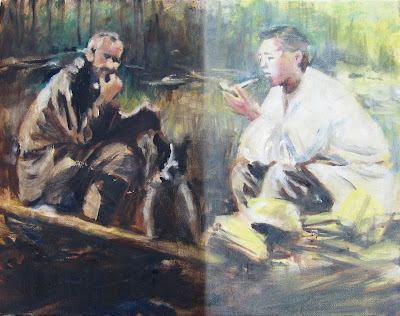 |
| V.G. Bogoraz/Chukchi folk tale narrator |
The CD series Voyage en URSS (Anthologie de la Musiques Instrumentale et Vocale des Peuples de l'URSS) consist of Russian recordings and was issued by the Le Chant du Monde label in 1990. I borrowed the CD from the Columbus Public Library sometime in 1999 or 2000. I was using cassette tapes back then and I recorded all volumes in the series. The last in the series: 6 - Caucase du Nord, Volga-Oural, Sibérie, Extrême-Orient, Extrême-Nord has been my favorite and I still occasionally play the tape. Back in the early 2000s it was my introduction to shamanic recordings and established my interest in shamanic culture. There are liner notes that I regret not copying back then but these do not contain images of the performers or the musicologists who recorded them. The musicologists aren't even listed and the information in the liner notes mostly deals with the instruments used, and the history of Russian folk music. All music was recorded between 1922 and 1983 and first appeared on the Soviet Melodiya label. The musicians are credited but in the twenty-odd years of looking, I have yet to find images of any of the musicians that have been featured in the Top 100. I have always used Russian folkloric images to illustrate these songs. My most current search to illustrate the song La Petite Poule (Danse Khantyl) by L. Tebetov brought me to pdf files of this wonderful Canadian magazine Inuktitut, published in three languages. An issue from 1988 is dedicated to the collaborations between (related) Siberian peoples and Canadian Inuits. The magazine has 124 pages full with photos, research, and travel documentation. I got excited by a photo published in this magazine of a Russian anthropologists in a boat interviewing a Chukchi folk tale narrator. That the song illustrated is not by a Chukchi but by a Khantyl didn't deter me. The little chicken of the title is not a folk tale either (as the title suggests), the vocals by Tebetov are echoic. The instrument used is a nars-loukh, a stringed instrument that sounds like a guitar. This is the first painting in the series of double portraits where the source image is also a double portrait. I decided, at the end of painting, to use transparent washes to separate the right half of the image from the left half.
The Russian song stands at a provisional number 29 at the Top 100 2021. I'm still finishing up the Top 100 2020 and I'll move forward one at a time on each list. In the 2020 list I have arrived at number 91 and the song I illustrated at the same time as the Russian song has a strong cultural connection to it. Chikap Upopo, performed by Kiyo Kurokawa and Teru Nishizima was recorded by Jean-Jacques Nattiez, a Canadian ethnomusicologist who specializes in the related vocal expressions of the Canadian Inuit, Russian Chukchi, and Japanese Ainu people. I painted Kiyo Kurokawa before and I always enjoyed to portray the Ainu with traditional face tattoos. Chikap Upopo comes from the UNESCO album Japan: Ainu Songs. 
Kiyo Kurokawa
No comments:
Post a Comment